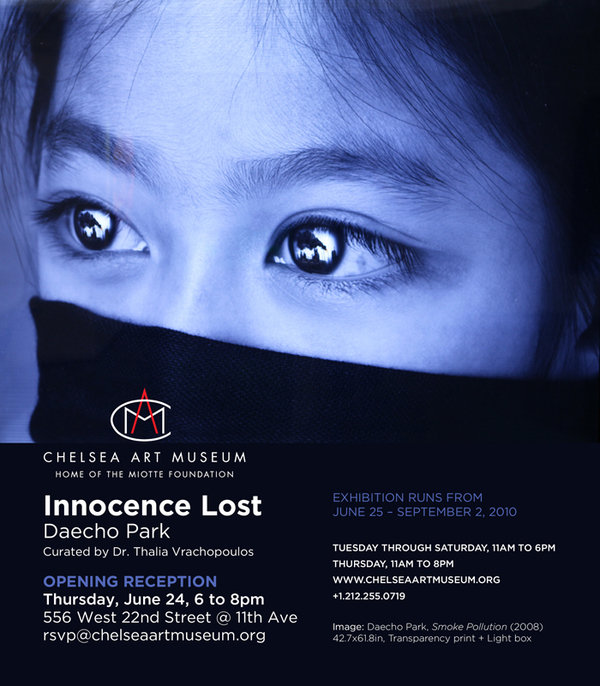Daecho Park
dal 23/6/2010 al 1/9/2010
Segnalato da
23/6/2010
Daecho Park
Chelsea Art Museum, New York
Innocence Lost. Daecho Park creates portraits of children affected by the trials of life yet at one with nature. In other words, he expresses that nature which although belabored by its steep climb through life, can maintain the innocence found in children. His portrayed sitters are metaphors of an existential moment during which they question not only the foundations of their lives but also, its meaning. Curated by Thalia Vrachopoulos.

Curated by Dr. Thalia Vrachopoulos
Daecho Park creates portraits of children affected by the trials of life yet at one
with nature. In other words, he expresses that nature which although belabored by
its steep climb through life, can maintain the innocence found in children. But,
while they appear innocent enough, these children bear the mark of desolation, loss
and pain that can often be glimpsed in their eyes. Park believes that our nature is
damaged by social and personal irrational desires.
His portrayed sitters are metaphors of an existential moment during which they
question not only the foundations of their lives but also, its meaning. This idea is
prevalent in Buddhism as well, and embraces the idea that our objective world is
only illusory and that we wil l suffer our humanity until we learn to let go of our
earthly desires. Indeed, Park grew up with Buddhist tenets in his proximity and
furthermore, he has incorporated them into his Taoist beliefs that emphasize the
rule of being at one with nature. His artworks as well as his written essays stem
from these two religious philosophies in synchrony.
Park has accomplished serious
work on Lao Tzu and Chuang-tzu who bel ieved that one must live with respect to
nature. For Park this is not some antediluvian throw back to religion, but arises
out of real concern for the environment and is revived as a viable philosophy to
place emphasis on the
benef its of a nature in harmony. The destruction of the ozone layer by air
pollution, water and soil contamination, ornuclear waste would have been
unimaginable to Park's ancestors.
Unlike the text portraits of Ralph Ueltzhoeffer who uses typeface to reference the
DOS digital language,
Park transfers his photographs of children on natural material such as stone. Then
he paints them often in monochrome or black and white to express the inclusion of
all color in one and the absence of all color in the other as a way of returning to
nature. Like Gerhard Richter, Park considers portraiture of utmost importance.
But,
Park and Richter t ransform the sitter whether media personality, real person, or
imaginary. These two artists have broadened the defini tion of the portrait genre
whi le challenging the standard model of art media. Park's work like Richter's
straddles the categories of painting and photography but Park broadens its
demarcation by his embrace of sculpture also. He engraves, carves or cuts into the
stone painting images that include grids or other ray lines that separate and
displace portions of the face like shafts of light as seen in his Binarity 2, 2008.
For more information please contact:
Chris Longfellow Press Officer The Chelsea Art Museum 212-255-0719 x 108
press@chelseaartmuseum.org
Curator Dr. Thalia Vrachopoulos at tvrachopoulos@gmail.com
Opening Reception: June 24, 6 - 8pm
Chelsea Art Museum
556 West 22nd Street, New York Cit, N.Y. 10011
Hours of Operation: Tuesday-Saturday, 11am-6pm.
Thursday, 11am -8pm



